Panini Sticker Alphabet

One hundred years ago, Giuseppe Panini was born in Pozza, a hamlet of Maranello, the first of the four brothers who made football stickers an Italian passion.
On November 9, 1925, one hundred years ago, Giuseppe Panini was born in Pozza, a hamlet of Maranello—a town in the province of Modena known worldwide for being the home of the Ferrari factory since 1943. He was the fourth child—the first son—of Antonio Panini, an agricultural mechanic, and Olga Cuoghi; four more children would follow Giuseppe. A tribe. Having moved to the capital in 1934, Antonio worked as a waiter at the Military Academy, and Olga, in 1945, ran a newsstand a few steps from Modena Cathedral. That year, albeit still in a tentative way, the entrepreneurial adventure of Giuseppe and his brothers began. In 1961, they published the first edition of Calciatori, the popular series of football stickers that has inspired at least five generations of children (and not only).
The following is the Panini Sticker Alphabet.
A for Panini Brothers Newspaper Distribution AgencyIn 1956, Giuseppe Panini and his brother Benito, three years younger, formed a company and obtained the exclusive distribution rights for the Gazzetta dello Sport in the province of Modena. Along with newspapers and magazines, the Paninis, from the heart of the newsstand on Corso Duomo, also sold other products: detective stories, photo novels, comics, and trading cards, packaged in "surprise" envelopes.
B as in Bruno BolchiBruno Bolchi (1940-2022), fifteen years as a professional footballer, and then almost forty as a coach , was the first sticker printed by Edizioni Panini, for the first album of the 1961-62 football season . At the time, Bolchi was the captain of Inter: a centre-half of notable physical prowess, Gianni Brera had nicknamed him Maciste.
C as in CyclistsNot just footballers. In 1971, Panini published the first sticker album dedicated to cycling. On the cover, Eddy Merckx in the yellow jersey at the Tour . Others followed in 1972 (again with Merckx, closely followed by Gimondi, on the cover), 1973, and 1979.
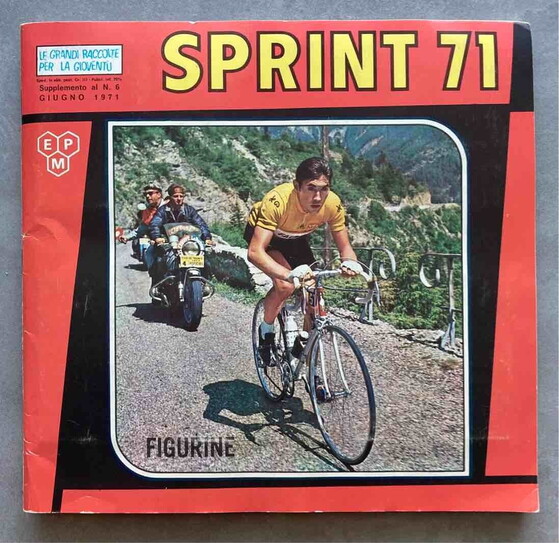
Throughout the history of Panini sticker collections, there have been occasional mix-ups. It began with the 1967-68 season album: the Spal sticker of Gildo Rizzato features a photograph of a young Ezio Vendrame ; in 1973-74, goalkeepers Giuliano Manfredi and Mirko Benevelli were swapped for Parma, playing in Serie B; in 1975-76, Genoa's centre-forward Roberto Pruzzo, also playing in Serie B, was swapped for Sergio Rossetti; and again, in 1980, the sticker of defender Claudio Azzali was actually a photo of his teammate and striker, Marco Ricci.
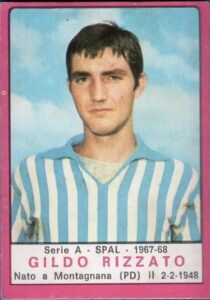
The Panini siblings are eight: Veronica, born in 1921, Norma in 1922, Maria Luisa in 1924, Giuseppe in 1925, Edda in 1927, Benito in 1928; Umberto in 1930; and Franco Cosimo in 1931.
G as in Luigi GarlandoLuigi Garlando, writer and journalist for the Gazzetta dello Sport, has dedicated a beautiful book to the Panini saga. It's titled " L'album dei sogni" (The Album of Dreams ) (Mondadori, 2021). Garlando writes: "As a child, I kept a sticker of Roberto Boninsegna, Inter's center forward, my hero, in my pocket, convinced I could carry his superpowers with me. I was certain that from the little rectangle of paper, kept in my shorts, the bull-like strength of my favorite champion would slide down my skinny legs." His book is also a portrait of generations of Italian kids raised on the motto "celo-manca" (I'm missing). In 2004, Garlando had already written a novel entitled Cielo manca (Here's Missing), in which stickers, and their linguistic and emotional "code," played a special role.
I as in UnfindablePierluigi Pizzaballa , born in Bergamo and now a sprightly eighty-six, was an excellent goalkeeper. During his long professional career (1958-1980), he played for Atalanta, Roma, Verona, Milan, and, finally, for his home team, Atalanta. He also boasts a cap for the Italian national team, in 1966. However, he has gone down in national football history for the fact that, in the 1963-64 season, he was among the most sought-after, and least found, cards in the Panini Footballers album . The reason for this has never been fully understood. It seems, however, that the most sought-after card on the collectors' market is that of Faustino Goffi, born in 1945, who appears in the 1967-68 album wearing the Padova shirt, who were in Serie B that year: in an auction on eBay, the card fetched 121 euros.
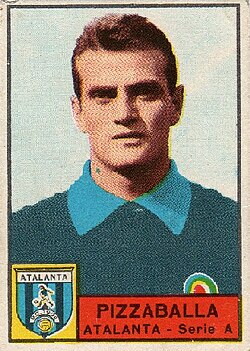
The cover of the first Panini Calciatori album, for the 1961-62 season, is dedicated to the great Nils Liedholm, who had retired from football the previous year. The Baron is portrayed about to head a brown leather ball.
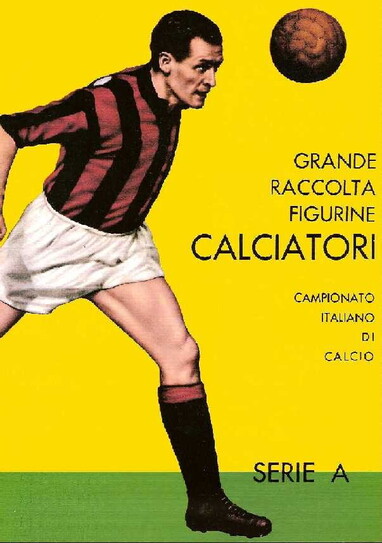
In 1996, Panini published its first album dedicated to African football, then just emerging. The occasion was the African Cup of Nations being held in South Africa. From Modena, they commissioned the undertaking—an impossible one at the time, given the pioneering era of the Internet—to a promising young freelance journalist: Filippo Maria Ricci. He successfully completed the assignment, involving a variety of diverse actors and intermediaries, including journalists, photographers, and federation officials. One last sticker, number 272 in the album, was missing before it went to print in due time: it was that of Matias Bebé, the elusive Mozambican player. It arrived at the last minute : but it was in black and white. But the Panini team didn't stop at these details: a generous coat of paint and off they went.
N as in NanninaIn 1960, the Panini brothers purchased an unsold batch of soccer stickers printed by Nannina in Milan. They packaged them in packs of four and put them on the market: they sold three million, earning 10 million lire. The following year, they invested this capital in their own sticker production.
Or like Olga PaniniOlga Cuoghi, at Panini, is the family's arzdora. Mother of eight, she has been the cornerstone of the company ever since she ran the newsstand near the Duomo, and even more so after the death of her husband, Antonio. In Modena, everyone knows and respects her as the "Casereina," the cheesemaker's daughter. She died in 1987 at the age of eighty-seven, in the midst of the first transfer of ownership to the English Maxwell Group.
P as in Via Emilio Po, 380This is the historic address of the Panini factory, where passionate young collectors would send their requests at the end of the season to complete their collections of missing stickers.
R as in ReverseThere's always an overhead kick, in the style of Panini stickers. The 1963-64 season album features Fiorentina defender Ardico Magnini, wearing the Italian national team jersey, performing an overhead kick. But the "iconic" overhead kick is the one that became the company logo starting in 1965-66 and was inspired by a photo taken by photojournalist Bruno Banchi during a Fiorentina-Juventus match on January 15, 1950. Taken from the bottom up—legend has it that Banchi was peeing in the long jump hole, emptied of sand, on the athletics track surrounding the Comunale stadium in Florence—the image was transformed into an illustration and then a trademark, and hundreds of millions of copies were published worldwide.
S as in Egidio SalviIf Pizzaballa was the unfindable, there was no place for Egidio Salvi, Brescia's slippery right winger, in the 1965-66 album. Due to a layout error, the album had no place to display his image, but the sticker was put on sale anyway, by mistake. A sort of pink Gronchi.
T as in Leo TurriniLeo Turrini, a journalist and writer from Sassuolo, successful author of numerous biographies on sports culture (from Enzo Ferrari to Gino Bartali, from Michael Schumacher to Ayrton Senna), has published for Minerva Edizioni, " Panini. History of a family and many stickers " (2020).
W for George WeahIf many of the Liberian national team players' names in the 1996 Africa Cup of Nations album were misspelled, if not entirely invented, it's all King George's fault. Liberia was among the last national teams to qualify for the final stage of the tournament, and the search for images of its players was extremely complex. Filippo Maria Ricci, an African expert for Panini, obtained portraits of the Liberian players from a Senegalese photographer, who were away in Dakar; but when the package of photos arrived, he also discovered that almost all of them were without names. He then enlisted the help of George Weah, then AC Milan's center forward, for facial recognition. But Weah wasn't too subtle, and gave many of his teammates incorrect or even made-up names. What on earth do you want to say to King George?
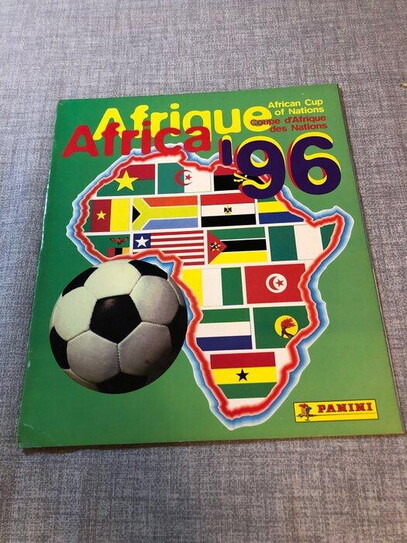
More on these topics:
ilmanifesto
